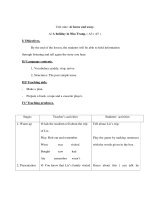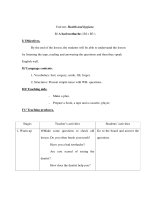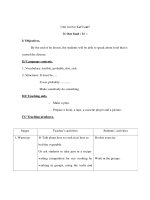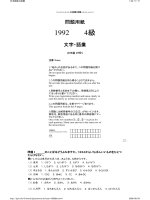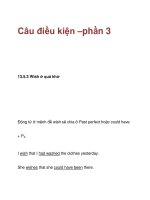Rapid GUI Development with QtRuby phần 3 pps
Bạn đang xem bản rút gọn của tài liệu. Xem và tải ngay bản đầy đủ của tài liệu tại đây (440.49 KB, 12 trang )
F
ridays
Chapter 4
Get Your Feet Wet
Instead of going through the routine of trying t o learn the arcane
details of QtRuby before using it, let’s jump straight into an exam-
ple.
4.1 Your first program
Fire up your favorite text editor, and type in this program:
➊
require
'Qt'
➋
app = Qt::Application.new(ARGV)
➌
label = Qt::Label.new(
"Hello World"
, nil)
➍
label.resize(150, 30)
➎
app.setMainWidget(label)
➏
label.show()
➐
app.exec()
Then, try executing it.
~> ruby ex_hello_world.rb
If all went well, your program should popup something like Fig-
ure 4.
1 .
Figure 4.1: Hello World Example
BOOKLEET ©
F
ridays
CHAPTER 4. GET YOUR FEET WET YOUR FIRST PROGRAM 20
Let’s take a closer, line-by-line, look.
By using the setCaption( ) method on your main
widget, you c an change the text that appears
in the window title bar of your application.
➊ First, we load the QtRuby library.
We typically pass Ruby’s ARGV array of
command line arguments to the Qt::Application
initial izer because QtRuby appli cations have
buil
t in support for
command line switches that
can alter the behavior of the program.
➋ Next, we create a Qt::Application object. Qt::Application is the foun-
dati
on for all
Qt programs. It handles all of the important behind-
the-scenes details that are vital to our program running prop-
erly.
➌ Creates a new Qt::Label object, and sets its text t o H ell
o World.
The nil argu ment will be explained shortly.
➍ Resize the label to 150 pixels wide by 30 pixels tall to make
sure the text is all visible.
➎ Assigns the label as the main widget of the application.
➏ Make the label visible.
Calling exec( ) is also known as starting the
event loop.
➐ Finally, we tell the application to start its processing.
Comparing to C++
For comparison, the equivalent C++ code is:
#include <qapplication.h>
#include <qlabel.h>
int main( int argc, char
**
argv )
{
QApplication app(
argc, argv );
QLabel label(
"Hello world!"
, 0 );
Report erratum
BOOKLEET ©
F
ridays
CHAPTER 4. GET YOUR FEET WET OBJECTS AND WIDGETS AND PARENTS, OH MY! 21
label.resize( 150, 30 );
app.setMainWidget( &label );
label.show();
return app.exec();
}
B
eing the very astute reader you are, wha t fundamental differ ences
did you notice between the tw o code styles?
Most importantly, you should have noticed the class names are
slightly different. In the
Qt world, all of the classes begin with the
l
ett
er Q, like QApplication. The Ruby equivalent, however, lives in the
Qt namespace, and as such, the Q is dropped. Thus, QApplication
becomes Qt::Application. This convention holds true for all QtRuby
classes.
From this point on, we will try to stick with the
Qt::Classname naming
QtRuby classes are all in the Qt namespace
(Qt::). You also drop the initial Q from the Qt
classname counterpart.
style when referring to classes, unless we are referring to something
that is Qt specific. Sometimes when we go deep into the Qt library,
we’ll need to use the QClass syntax instead.
Now that your feet are wet, let’s wade a little deeper into the frame-
work.
4.2 Objects and Wid gets and Parents, oh my!
We’ve created our first QtRuby program and highlighted a couple
of nec
essities. We’re ready to go a little deeper, but first we need to
understand a little more about the basics of
Qt.
Report erratum
BOOKLEET ©
F
ridays
CHAPTER 4. GET YOUR FEET WET OBJECTS AND WIDGETS AND PARENTS, OH MY! 22
Qt::Object
Qt::Widget
Qt::Label
Figure 4.2: Qt::Label Inheritance Diagram
Fundamen tals
The fundamental class in QtRuby is the Qt::Object. This object con-
tains
many of the sett ings and properties that are needed in most of
the classes we will be using.
Directly inheriting from
Qt::Object is the Qt:: Widget class. Qt::Widget is
Qt::Object is a common base class for other
items in QtRuby th at aren’t GUI widgets, but
may need some of the same base properties.
the base class for all GUI items, like sliders, text boxes, and labels.
1
In fa ct, the Qt::Label class we used in the example on page on page 19
inherits from Qt::Widget.
The
Qt:
:Widget class by itself is rather boring. We like to think of it
a
s a blank canvas on which we can make a more interesting type of
widget. Luckily for us, many of the commonly used types of widgets
have already been created as part of the framework, such as the
1
In general, any GUI object is referred to generically as a widget
Report erratum
BOOKLEET ©
F
ridays
CHAPTER 4. GET YOUR FEET WET OBJECTS AND WIDGETS AND PARENTS, OH MY! 23
Figure 4.3: Qt::Label, Qt::SpinBox and Qt::TextEdit
Qt::Label, Qt::SpinBox, and Qt::TextEdit (screenshot on Figure 4.3 ).
Qt::Widget is a good base class to use to make more
soph
sticated widgets.
As seen in the previous code example, the way to bring a widget alive
is to initialize it with a call to new( ). Fo r example, this code creates
a new Qt::Widget instance:
Most widgets have multiple initializers taking different
arguments lists.
widget = Qt::Widget.new(nil)
Object ancestry
But what is this mysterious parameter we’ve been passing to t he
Classes derived from Qt::Widget must have a
Qt::Widget based parent.
Classes derived from Qt::Object only need a
Qt::Object derived parent, which includes
Qt::Widget.
initializer, you ask? It’s the parent argument. Every time you create
a new widget, you tell that widget who its parent widget is. Option-
ally, by passing nil, you’re telling the widget it has no parent.
w1 = Qt::Widget.new(nil) # No parent
w2 = Qt::Widget.new(w1) # w1 is parent
Report erratum
BOOKLEET ©
F
ridays
CHAPTER 4. GET YOUR FEET WET OBJECTS AND WIDGETS AND PARENTS, OH MY! 24
toplevelwidget
child_1 child_2
Some Text
child_3
Figure 4.4: More C omplex Inheritance Hierarchy
Parentless widgets are called top level widgets.
Here’s a slightly more complex ex ample, shown diagramatically in
Figure
4.4
Line 1
# Create a widget with no parent
-
toplevelwidget = Qt::Widget.new(nil)
-
# Create children of the toplevelwidget
-
child_1 = Qt::TextEdit.new(toplevelwidget)
5
child_2 = Qt::ComboBox.new(toplevelwidget)
-
# Create a grandchild of the toplevelwidget
-
child_3 = Qt::Label.new(
"Some Text"
, child_1)
How the family fits together
A parent widget owns its children. Child widgets become contained
A widget can be given a new parent using the
reparent( ) method.
within the physical geometry of t he parent. Thus, if the parent gets
d
e
s
t
royed, disposed of, or hidden, its children will also suffer the
same fate. This feature is very valuable. We can creat e child widgets
knowing that as long as they have a parent they will be cared for. If
Report erratum
BOOKLEET ©
F
ridays
CHAPTER 4. GET YOUR FEET WET OBJECTS AND WIDGETS AND PARENTS, OH MY! 25
child child
Parent widget
Figure 4.5: A parent widget with two contained children
this wasn’t the case, we could potentially have lots of spare widget s
floating (literally) around.
For example, if you destroyed the
toplevelwidget from line 2 above, you
c
an b
e assured that child_1 and child_2 are destroyed. child_3 would
also be destroyed, since its parent, child_1, wa s destroyed.
Why parents and chil dren?
You may be wondering the logic behind having to specify a parent
when creating a new instance of a widget. It t urns out that this
methodology fits the GUI model very well.
The parent/child model allows us to creat e object s and then
not w
orry about their ownership. After creation, QtRuby
handles all of the detail s for us.
The common convention is to ha ve one top level widget for the appli-
cation of which all the other widgets are children or grandchildren
(or great grandchildren. . . ). The top level widget for the application
can be the blank canvas of a
Qt::Widget or a more complex application
i
nt
e
r
face like a Qt::MainWin dow.
Report erratum
BOOKLEET ©
F
ridays
CHAPTER 4. GET YOUR FEET WET THE QT OBJECT MODEL 26
The parent/child relationship is also used by Qt to help with the
physi
cal layout o f the windows in the application, something we’ll
see more of Section
5.3, Understanding Layouts, on page 38.
Naming widgets
As well as the parent argument, Qt::Obje ct-based initializers a lso
accept an optional name argument. It is passed in immediately after
the parent, like this:
widget = Qt::Widget.new(parent_widget,
"Fred"
)
The na me can also be specified using the setName( ) method.
widget = Qt::Widget.new(parent_widget) # Nameless
widget.setName(
"Fred"
)
Widgets whose names are not specified receive t he name unna
med.
We find that i n pract i c e , naming your widgets isn’t all that
important.
We re c ommend using Ru by’s object introspection methods
over their QtRuby counterparts if possible, as they’re
notably faster. For example, we benchmarked Ruby’s
class( ) method as four times faster than Qt::Object’s
c
lassName( ) method.
As we’ll see in the next section, there are ways to search groups
of widgets by name, which is a reason why authors may choose
to name their widgets. Another reason is that debugging and intro-
spection tools can provide valueable insight when widgets have names.
If your program has 100
Qt::Labels in it, and one of them was causing
the program to crash, knowing the name of which one can help you
track down the bug much faster.
4.3 The Qt Object Model
Through the heavily used base class Qt::Object, Qt provides a va lu-
able
set of introspection methods t hat can be used to query infor-
mation about objects and their families. Many of these methods are
fundamental to Ruby applications, but remember that
Qt is a C+ +
Report erratum
BOOKLEET ©
F
ridays
CHAPTER 4. GET YOUR FEET WET THE QT OBJECT MODEL 27
toolkit and as such some of these ideas are not central to that lan-
guag
e.
First,
Qt::Object provides a className( ) method that returns the name
o
f the class. Ruby provides the same information via the class( ) call.
irb(main):001:0> w = Qt::Widget.new(nil)
irb(main):002:0> w.className
=> "Qt::Widget"
irb(main):003:0> w.class
=> Qt::Widget
Object types are also queryable via the isA( ) and inherits( ) methods.
isA( ) returns tr ue if the object is an inst ance of the class. inherits( )
returns true if the object has some inheritance back to the provided
clas
s.
irb(main):004:0> w.isA("Qt::Widget")
=> true
irb(main):005:0> w.isA("Qt::Object")
=> false
irb(main):006:0> w.isA("QWidget")
=> false
irb(main):007:0> w.isA("QObject")
=> false
irb(main):008:0> w.inherits("Qt::Widget")
=> true
irb(main):009:0> w.inherits("Qt::Object")
=> true
irb(main):010:0>
w.inherits("QWidget")
=> true
i
rb(main):011:0> w.inherits("QObject")
=> true
No
te that in the previous example, inherits( ) r eturns true for both
QObject and Qt::Object syntax. In previous versions of QtRuby, this
Report erratum
BOOKLEET ©
F
ridays
CHAPTER 4. GET YOUR FEET WET THE QT OBJECT MODEL 28
Qt::Object
Qt::Widget
className()
"Qt::Widget"
isA("Qt::Widget")
true
isA("Qt::Object")
false
inherits("QObject")
true
Figure 4.6: Widget Inheritance Methods
was not the case; inherits( ) only returned true if you used the Qt style
naming
convention. Be careful of this fact if you are not using the
most recent version available of QtRuby.
Studying the Family
We can also inspect a widget’s relatives. The parent( ) and children( )
methods return the widget’s direct ancestors.
Note: The output from the irb int
erpreter has been
formatted a little so its easier to read.
irb(main):013:0> w = Qt::Widget.new(nil)
irb(main):014:0> w2 = Qt::Widget.new(w)
irb(main):015:0> w3 = Qt::Widget.new(w)
irb(main):017:0> w2.parent == w
=> true
irb(main):016:0> w.children
=> [ w2, w3 ]
The children( ) method returns the widget’s children in the order in
Report erratum
BOOKLEET ©
F
ridays
CHAPTER 4. GET YOUR FEET WET THE QT OBJECT MODEL 29
parent
child child
parent()
children()
Figure 4.7: Parent and C hildren method calls
which they were created as children o f the widget. The children( )
method returns only direct children of the parent, not grandchil-
dren.
To explicitly search for a child, you can use the
child( ) method. The
synta
x is child(name, inheritsClass = nil, recursiveSearch = true).
# Search all children and grandchildren
# for a child named "Editor"
obj = w.child(
"Editor"
)
# Search all children and grandchildren
# for a Qt::LineEdit named "Editor"
obj = w.child(
"Editor"
,
"Qt::LineEdit"
)
# Search only direct children
# for a child "Editor"
obj = w.child(
"Editor"
, nil, false)
# Search only direct children
#
for
a
Qt::LineEdit
named "Editor"
obj = w.child(
"Editor"
,
"Qt::LineEdit"
, false)
Report erratum
BOOKLEET ©
F
ridays
CHAPTER 4. GET YOUR FEET WET OTHER INITIALIZATION ITEMS 30
The child( ) method returns the first child found fit ting the search
crite
ria. To query for multiple children, the queryLi st( ) method can be
used. The syntax is
queryList(inheritsClass = nil, objName = nil, regexpMatch =
true, recursiveSearch = true)
irb(main):004:0> w = Qt::Widget.new(nil)
irb(main):005:0> w2 = Qt::Widget.new(w,"Widget")
irb(main):006:0> w3 = Qt::Widget.new(w,"Widget3")
irb(main):007:0> w4 = Qt::Widget.new(w,"Foo")
irb(main):012:0> w.queryList("Qt::Widget")
=> [ w2, w3, w4 ]
irb(main):013:0>
w.queryList("Qt::Widget","Widget")
=> [ w2,
w3 ]
irb(main):013:0> w.queryList("Qt::Widget","Widget", false)
=> [ w2 ]
4.4 Other initialization items
Notice line 7 from the example on page 24.
child_3 = Qt::Label.new(
"Some Text"
, child_1)
The initialization of the Qt::Label class also includes a string literal to
set the label’s value. This is very common practice wit h Qt widgets—
many have initializers which can take extra arguments to seed ini-
tial settings of the widget. One thing to note: the parent argument
usually comes after these initial value arguments.
Indeed, we also could have written:
child_3 = Qt::Label.new(child_1)
c
hild_3.setText(
"Some Text"
)
You can also pass a block to the object initializer if preferr ed.
Report erratum
BOOKLEET ©
